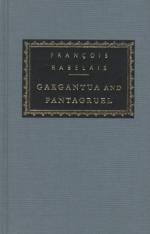Louis Guyon, in his Diverses Lecons, is still more positive: ’As to the last book which has been included in his works, entitled l’Ile Sonnante, the object of which seems to be to find fault with and laugh at the members and the authorities of the Catholic Church, I protest that he did not compose it, for it was written long after his death. I was at Paris when it was written, and I know quite well who was its author; he was not a doctor.’ That is very emphatic, and it is impossible to ignore it.
Yet everyone must recognize that there is a great deal of Rabelais in the fifth book. He must have planned it and begun it. Remembering that in 1548 he had published, not as an experiment, but rather as a bait and as an announcement, the first eleven chapters of the fourth book, we may conclude that the first sixteen chapters of the fifth book published by themselves nine years after his death, in 1562, represent the remainder of his definitely finished work. This is the more certain because these first chapters, which contain the Apologue of the Horse and the Ass and the terrible Furred Law-cats, are markedly better than what follows them. They are not the only ones where the master’s hand may be traced, but they are the only ones where no other hand could possibly have interfered.
In the remainder the sentiment is distinctly Protestant. Rabelais was much struck by the vices of the clergy and did not spare them. Whether we are unable to forgive his criticisms because they were conceived in a spirit of raillery, or whether, on the other hand, we feel admiration for him on this point, yet Rabelais was not in the least a sectary. If he strongly desired a moral reform, indirectly pointing out the need of it in his mocking fashion, he was not favourable to a political reform. Those who would make of him a Protestant altogether forget that the Protestants of his time were not for him, but against him. Henri Estienne, for instance, Ramus, Theodore de Beze, and especially Calvin, should know how he was to be regarded. Rabelais belonged to what may be called the early reformation, to that band of honest men in the beginning of the sixteenth century, precursors of the later one perhaps, but, like Erasmus, between the two extremes. He was neither Lutheran nor Calvinist, neither German nor Genevese, and it is quite natural that his work was not reprinted in Switzerland, which would certainly have happened had the Protestants looked on him as one of themselves.
That Rabelais collected the materials for the fifth book, had begun it, and got on some way, there can be no doubt: the excellence of a large number of passages prove it, but—taken as a whole—the fifth book has not the value, the verve, and the variety of the others. The style is quite different, less rich, briefer, less elaborate, drier, in parts even wearisome. In the first four books Rabelais seldom repeats himself. The fifth book contains




